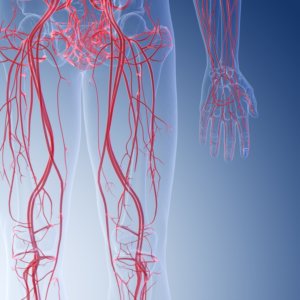The relation between peripheral circulatory disorders and lack of omega-3 fatty acids
 Peripheral circulatory disorders are primarily caused by clogged blood vessels in the extremities. Symptoms typically include walking-induced leg pain, cold hands and feet, or impotence caused by a poor blood supply. According to a new study that is published in the science journal Lipids, people with peripheral circulatory disorders have lower levels of omega-3 in their blood compared with people who do not suffer from these diseases. Omega-3 is believed to have several mechanisms that protect against atherosclerosis. It is also important to make sure to consume omega-3 in the right balance with omega-6.
Peripheral circulatory disorders are primarily caused by clogged blood vessels in the extremities. Symptoms typically include walking-induced leg pain, cold hands and feet, or impotence caused by a poor blood supply. According to a new study that is published in the science journal Lipids, people with peripheral circulatory disorders have lower levels of omega-3 in their blood compared with people who do not suffer from these diseases. Omega-3 is believed to have several mechanisms that protect against atherosclerosis. It is also important to make sure to consume omega-3 in the right balance with omega-6.
Peripheral circulatory disorders are primarily a result of clogged blood vessels surrounding the brain and the heart. The atherosclerosis is caused by deposits of oxidized cholesterol (plaque) and, in the later stages, calcium on the inside of the arteries, causing them to thicken. As time goes by, the oxygen supply is reduced, and it becomes easier for blood platelets to aggregate and form clots.
Atherosclerosis has different stages and is characterized by free radicals and inflammation. Free radicals are aggressive molecules that attack cholesterol, which is normally an essential compound. Stress, smoking, poisoning, large waist circumference, type 2 diabetes, and ageing can step up the formation of free radicals and subsequent inflammation. This leads to oxidation and destruction of cholesterol, causing the cholesterol to form deposits in the vessel walls with help from white blood cells. It is not the cholesterol that is the culprit is. It is the free radicals and the inflammatory processes.
|
Omega-3’s different mechanisms against atherosclerosis
We have omega-3 fatty acids in all our cell membranes. The two omega-3 fatty acids, EPA and DHA, that are found in fish and fish oil help control a number of biochemical processes in the cells. Omega-3 fatty acids also work in a biochemical interplay with omega-6 fatty acids. It is therefore vital to consume omega-3 and omega-6 in the right balance.
Scientists have discovered that omega-3 fatty acids help improve the endothelial function of the cellular layer that lines the inside of the blood vessels. Endothelial cells are of particular importance for the minute capillaries that deliver blood to the tissues and organs. Endothelial cells also function as security guards that register microorganisms and other harmful compounds in the blood. Endothelial cells are able to attract white blood cells and instruct them what to attack
It is important that the body is able to fight infections and poisonings swiftly and effectively. However, the immune defense must never overreact with chronic inflammation because this floods the body with free radicals that are extremely damaging.
As a general rule, the omega-6 fatty acid AA (arachidonic acid) promotes inflammation, while the omega-3 fatty acid EPA (eicosapentaenoic acid) inhibits inflammation. It is therefore vital to have the right balance between these two fatty acids. The problem is that Western diets are out of balance and contain far too little omega-3 from oily fish and far too much omega-6 from plant oils, margarine, chips, and ready meals.
Omega-3’s role in the peripheral circulatory system
- It Improves the endothelial function
- It helps the relaxation of smooth muscle tissue around the blood vessels
- It has an anti-inflammatory function
- It has an indirect antioxidant function (inhibits inflammation)
- It delays the development of atherosclerotic plaque
- It improves the stability and flexibility of blood platelets
- It counteracts blood clots
The study
Because atherosclerosis is the main cause of peripheral circulatory disorders in the legs, the researchers assumed that an omega-3 deficiency could be an underlying cause. In order to study the link between omega-3 and peripheral circulatory disorders, they compared 145 patients with such disorders with 35 healthy controls
The scientists discovered that patients with peripheral circulatory disorders had significantly lower blood levels of omega-3. When they adjusted for confounding factors such as age, smoking habits, blood pressure, drug use etc. they still had lower blood levels of omega-3 compared with the control group.
According to PhD Bill Harris, who headed the study, the anti-inflammatory effect of omega-3 is most likely the explanation. The scientists therefore plan to investigate if increased consumption of oily fish may help prevent peripheral circulatory disorders.
How much omega-3 do we need?
International recommendations for omega-3 intake lie in the range of 500 mg to 1 gram daily, and oily fish such as herring, salmon, trout, and mackerel are excellent sources. People who don’t like oily fish or simply eat too little to reach the recommended intake level can take a fish oil supplement, instead. Just make sure to choose a product that has good quality.
The following dosages (daily) are recommended by international experts:
- 1 gram for proactive support (e.g. for a well-functioning circulation)
- 2-4 grams for intensive supports (e.g. inflammation and aching joints)
Other non-medical strategies for treating peripheral circulatory disorders
|
References
James Ives. People with peripheral artery disease have lower Omega-3 index, shows study. News Medical Life Science 2019
GT Chua et al. Vitamin D status and peripheral arterial disease: evidence so far. Vasc Health Risk Manag. 2011
https://pro.medicin.dk/Sygdomme/Sygdom/318366.
https://www.medicin.wiki/aterosklerose/
http://denstoredanske.dk/Krop,_psyke_og_sundhed/Sundhedsvidenskab/Cellebiologi_og_almen_histologi/endothel
https://altomkost.dk/raad-og-anbefalinger/de-officielle-kostraad/spis-mere-fisk/
Search for more information...
- Created on .








